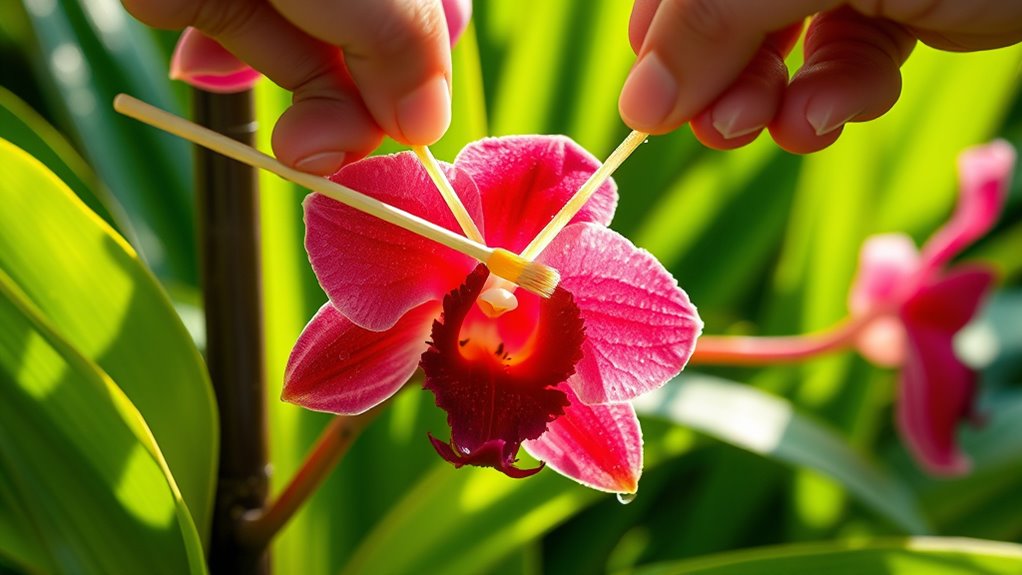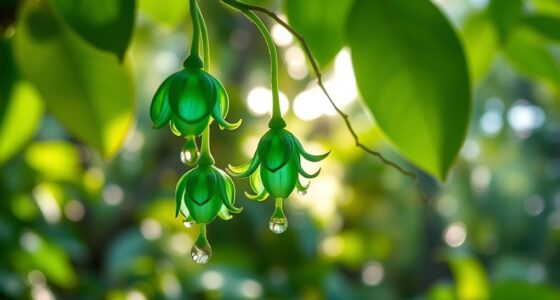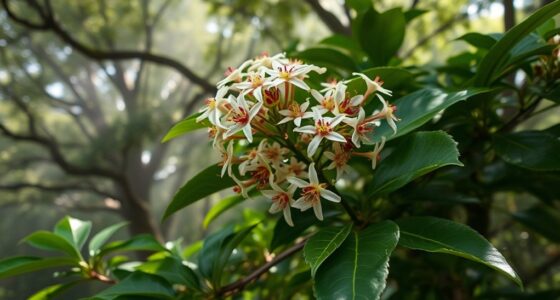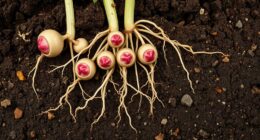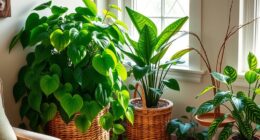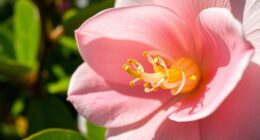If you’re hand-pollinating rare summer-blooming plants, you play a crucial role in ensuring seed production when natural pollinators are scarce or unreliable. Carefully collect pollen from healthy donor flowers and gently transfer it to receptive stigmas using a fine brush or cotton swab, ideally during peak flowering. Conduct these actions under ideal conditions to maximize success. Keep in mind, mastering these techniques can greatly boost your plant’s chances for future growth, so explore more to make your efforts even more effective.
Key Takeaways
- Collect pollen from healthy donor flowers during peak flowering and carefully transfer it to receptive stigmas using fine tools.
- Perform hand-pollination during optimal environmental conditions to maximize pollen viability and seed production.
- Understand each plant’s reproductive biology to ensure compatibility and improve seed set success.
- Document and refine techniques to enhance seed viability, germination rates, and long-term conservation outcomes.
- Combine hand-pollination with habitat management to support natural pollination and boost overall plant survival.
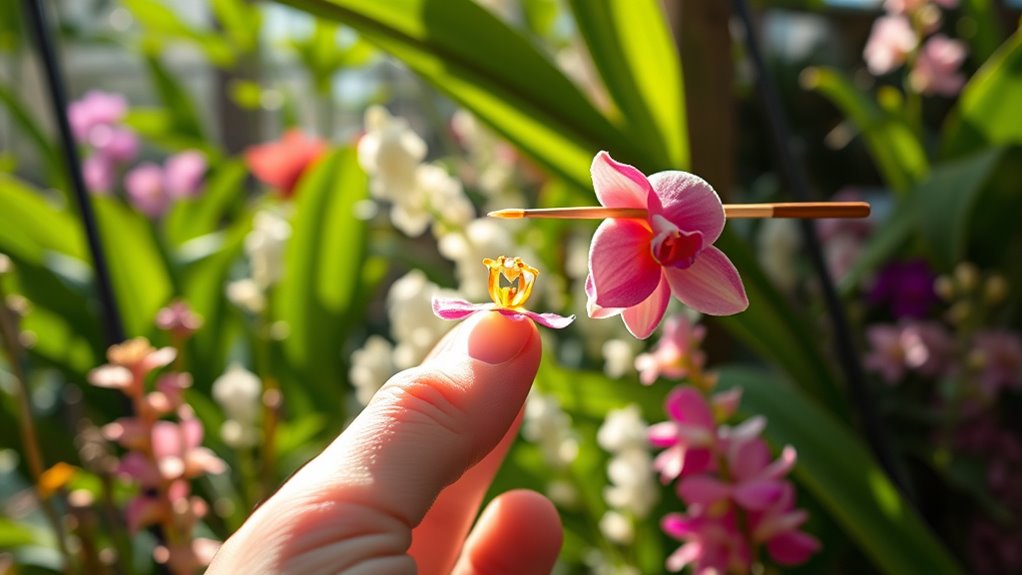
When rare plants face declining populations, hand-pollination becomes an essential tool to help guarantee their survival. This technique allows you to directly transfer pollen from one flower to another, bypassing natural pollinators that may be scarce or unreliable. By carefully managing pollination techniques, you can increase the chances of successful seed set, which is indispensable for the conservation of these delicate species. Hand-pollination is especially important for summer bloomers that produce their seeds within a narrow window, ensuring that each flowering cycle results in viable offspring. It’s a proactive conservation strategy that complements other efforts like habitat preservation and seed banking, giving these plants a better shot at thriving despite environmental pressures.
To implement effective pollination techniques, you need to understand the reproductive biology of the plant species you’re working with. Some plants are self-compatible, meaning they can fertilize themselves, while others require cross-pollination from a different plant. Identifying the correct method involves observing flower structures and timing your intervention when the flowers are receptive—usually when the stigma is sticky or open. Using fine-tipped brushes or cotton swabs, you gently collect pollen from the anthers of a donor flower and transfer it to the stigma of a recipient flower. You should do this during the plant’s peak flowering period to maximize pollen viability. Keep in mind that environmental factors like humidity and temperature can influence pollen success, so conducting hand-pollination under excellent conditions is essential. Proper timing plays a crucial role in boosting the effectiveness of your efforts.
Consistent application of pollination techniques helps strengthen conservation strategies by ensuring that rare plants produce enough seeds for future propagation. It also allows you to control genetic diversity, selecting pollen donors to avoid inbreeding depression. Properly timed and executed hand-pollination can dramatically improve seed viability and germination rates, which are critical for successful reintroduction projects. Documenting your efforts—such as noting the date, plant identity, and pollination outcome—helps refine your approach over time. This data supports broader conservation strategies by providing insights into reproductive success and potential genetic bottlenecks.
Ultimately, hand-pollination isn’t just about boosting seed production; it’s about actively participating in the preservation of rare plants. When combined with habitat restoration and protective measures, it forms an all-encompassing conservation strategy that increases the likelihood of these species surviving and flourishing in their natural environments. Your hands-on efforts can make a significant difference, especially during critical flowering periods in summer, ensuring that these plants continue to grace their ecosystems for generations to come.
Frequently Asked Questions
How Do I Identify the Right Pollination Time for Rare Plants?
You need to observe your rare plants closely to identify the right pollination timing. Watch for flower maturity, which is when petals are fully open and receptive to pollen. Typically, pollination should occur just as flowers reach this stage to maximize seed set. Timing is essential; if you wait too long, the flowers may start to fade, reducing the chances of successful pollination. Keep a daily watch to catch the perfect moment.
What Tools Are Best for Hand-Pollinating Delicate Flowers?
To hand-pollinate delicate flowers, you’ll want to use micro dissecting tools for precision and soft paintbrushes to gently transfer pollen without damaging the flowers. Micro dissecting tools allow you to handle tiny parts carefully, while soft paintbrushes provide a gentle touch, guaranteeing pollen transfer is smooth. These tools help maximize pollination success, especially with fragile plants, so you can ensure they set seed and thrive for future seasons.
Can Hand-Pollination Harm the Plant or Reduce Its Health?
Hand-pollination can pose minimal risks to plant health if done carefully, but it does carry some pollination risks. If you handle the delicate parts roughly or use dirty tools, you might harm the plant or introduce diseases. To avoid this, be gentle and sterilize your tools. When done correctly, hand-pollination is safe and helps ensure seed set without considerably affecting the plant’s overall health.
How Do Environmental Factors Affect Hand-Pollination Success?
Environmental influences like temperature, humidity, and wind considerably impact your hand-pollination success. You need to pay attention to pollination timing, ensuring it aligns with the plant’s natural flowering period for ideal results. Warm, dry conditions often boost pollen transfer, while high humidity can hinder it. Wind may either aid or disrupt pollen movement. Adjust your approach based on these environmental factors to maximize seed set and plant health.
What Should I Do if the Plant Does Not Set Seed After Pollination?
Sometimes, despite your efforts, seed set doesn’t happen as expected. If the plant doesn’t produce seeds, it could be due to issues like reduced flower viability or pollen contamination. First, check if the flowers are healthy and receptive. You might try hand-pollination again, ensuring pollen is pure and transferred at the right time. Patience and careful observation can improve chances of success, helping your rare plants thrive.
Conclusion
By hand-pollinating rare plants, you play a essential role in preserving their beauty and ensuring their survival for future summers. Your gentle efforts can make a real difference in boosting seed production and supporting biodiversity. Isn’t it rewarding to know that your hands can help these delicate species thrive? Keep learning, stay patient, and continue your critical work—your care can help these rare plants flourish for generations to come.

